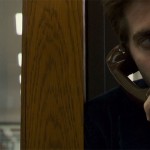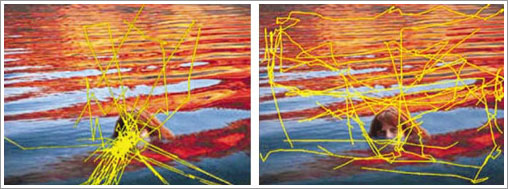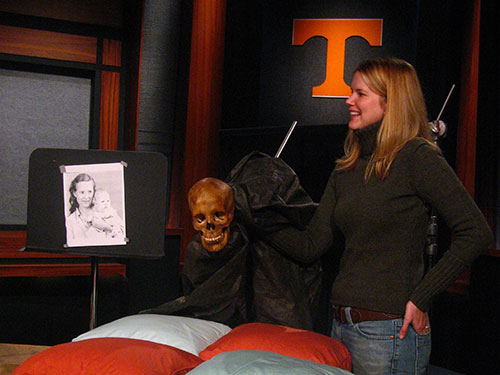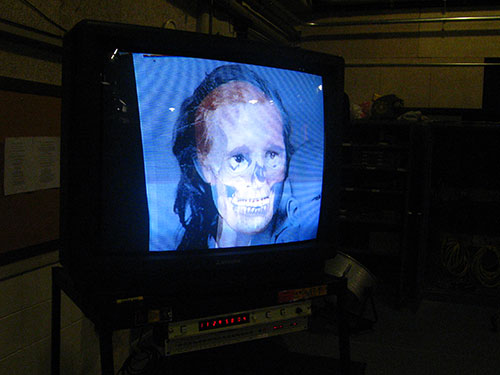David Fincher’s Zodiac is absolutely haunted by the specter of technology and by the present-day confidence we have in its objectivity. Throughout the film, Fincher inserts strange little moments that foreground communication and investigation technologies: a cop in San Francisco is disappointed when he learns that an officer in another precinct can’t “telefax” some evidence to him, the same SF cop pulls over to the side of the road to use a Police Emergency telephone, the obsessed writer fills his apartment with boxes and boxes of mimeographed documents, a suspect is let go because a handwriting authority (whose “authority” is later questioned) claims he can’t be the killer. Aside from the requisite, grisly recreations of three Zodiac murders in the first act, this film, which is easily my favorite Hollywood production of the year, has little in common with serial killer movies. Rather, it’s a fascinating and deliberate (I assume) commentary on our current cultural obsession with techno-forensic porn.
Author: Darren
-
Recent Developments
Today is August 16th, which means an entire month has passed since my last post here. I believe that’s a first in the six-year history of Long Pauses. My blogging time has, instead, been spent over at my other site, 1st Thursday, where are a bunch of us are breathlessly anticipating what is shaping up to be a ridiculous film festival. Despite the fact that I’ll be in Toronto for 11 days with a Festival Pass that allows me to see as many as 50 films, I’m slowly coming to realize that I’ll still have to pass on a lot of great movies. It’s an embarrassment of riches, really.
In other news:
I’ve finally joined the 20th century and gotten a cell phone. Because I’m a whore to Steve Jobs I bought an iPhone, and it is, indeed, awesome. I can’t stop touching it. Here’s my first custom wallpaper.
I’ve almost completely stopped buying DVDs, but after watching Jacques Tourneur’s Cat People and Leopard Man recently, I happily sent $39.71 to Deep Discount for the Val Lewton Horror Collection. It’s quickly proving to be my favorite film experience of the year.
A word of advice: Think twice before buying a 30-year-old home. 30 years seems to be the exact timespan required to exhaust a home’s infrastructure — things like, say, air conditioning units. Ours died on a day when the heat index here hit 105. Good times. Another word of advice: When the contractor says it’ll take 2-3 weeks to relandscape and get the pool working again, he really means, “You might see me and my ‘crew’ a couple times over the next two months, but don’t worry, we’ll stop by often enough to totally destroy your yard. Oh, and I hope you weren’t planning to swim at all this year. Because you won’t.”
Because I spend 9-10 hours a day hunched over a computer in a windowless office, I’m always on the lookout for things to keep my mind occupied, and my latest obsession is the Charlie Rose archive. Granted, Rose is a bit of a tool, and he frequently commits the Great Sins of Interviewing — not listening to guests and interrupting them — but his archive is really deep. And his site allows the sharing of videos. Let’s see if this works:
-
P. Adams Sitney on Film Bloggers
The other day I was talking to a group of younger filmmakers about a current situation I simply cannot understand. There seems to be a tremendous revitalization of avant-garde filmmaking now, but there’s absolutely no one publishing anything about it, anything. . . .
The universities have completely imploded. They’re the places to go if you believe that the media discourse of French philosophers is the only viable approach to film, and that the empirical relationship of the viewer to the work of art is utterly passe. . . .
I can only fantasize about young independent people who love these new films and want to write about them.
— in an interview with Scott MacDonald, A Critical Cinema, Vol. 4, May 2000
Okay, so technically he wasn’t talking about film bloggers. Or, at least he didn’t know he was talking about film bloggers.
-

Vermicide
A recent conversation while driving home from Lowe’s:
“How is it possible for a human voice to make that sound?”
“I think it’s Mars Volta. . . . Rush for the new millennium.”
“It’s like there has to be one of those guys every generation. It’s just wrong.”
[pregnant pause]
“But you dig the song, right?”
“Absolutely. Don’t you?”
“I haven’t changed the station yet. . . . You just like the angst.”
“Yep. That’s why most of the music you like sucks. Not enough angst.”
“Well, most people outgrow angst, like, after puberty.”
“Whatever.” -

Early Lynch
After watching The Elephant Man, Eraserhead, and David Lynch’s short films, all for the first time and in short succession, what’s most striking is the seamlessness of Lynch’s evolution from art school animator to studio hire. It’s almost impossible to imagine a more ideal scenario for the young filmmaker. After laboring for the better part of a decade on The Grandmother and Eraserhead, two highly original, intimate, and still-shockingly strange films, Lynch had the remarkable good fortune of being championed by Jonathan Sanger and Mel Brooks (of all people), who invited him to direct The Elephant Man, a relatively traditional script that suited perfectly his already fully-formed aesthetic and thematic concerns.
At the risk of psychoanalyzing the young Lynch, it seems safe to say that his early work is steeped in anxiety. Like so many fables before it, The Grandmother is a fantastical tale of a child’s struggle to escape corruption and cruelty by restoring the foundations of his lost and mythical “traditional family.” Love and death are ethical and metaphysical issues for Lynch, but they’re bound up in biology, too. Human flesh and organic processes are mysterious, unreliable, and frightening in these films. You can practically smell the decay. In Eraserhead, the anxiety is more specifically sexual: given the film’s grim cast of seductresses, spermazoid parasites, and foetal nightmares — not to mention one terrified young man — it should come as no surprise that a quick Google of “David Lynch” and “Freud” returned more than a hundred thousand hits.
Having seen various clips from The Elephant Man over the years — “I am not an animal” and all that — I was caught unprepared by the film’s opening sequence, which is almost identical in style and tone to Eraserhead. Like John Merrick in his coat and tie, Lynch’s first Hollywood production is more refined and respectable, perhaps, but it’s a wonderful oddity, nonetheless. Intercutting Freddie Francis’s black-and-white portrait of slow-moving elephants with fever-dream images of Merrick’s desperate mother, Lynch immediately reestablishes his old preoccupations — myth and archetype (“Leda and the Swan” for starters), sexual anxiety, nostalgic longing for family, and the loss of innocence — all of them refracted through the particular prism of Lynch’s imagination. He’s an odd guy, let’s face it, with a keen ability to transform even the most benign of objects (a pile of dirt, a baked hen, an oval portrait) into something genuinely Uncanny, in the Freudian sense. The Elephant Man, like the two films that preceded it, is so laden with harbingers of loss and ruination, Merrick’s actual death at the end of the film seems redundant.
-
Can I Go Home Now?
Watching this video it occurs to me that, instead of the presidency, this guy would have been much happier if he’d inherited a West Texas Chrysler dealership. I have to admit that I more or less supported Bush’s immigration plan. It’s the first time in six-and-a-half years I’ve been able to say that about a White House policy.
-
A Toast to Cinephilia!
Thursday night, during my third and final flight of the day, I sat next to one more stranger and attempted to explain, once again, why I was flying from East Tennessee to Toronto.
“Well, see, there’s this Portuguese filmmaker I really like, and the Cinematheque Ontario has pulled together all of his films, several of which are really difficult to see, and they’re also showing this other film that’s even more rare, and I’m thinking about contributing a chapter about this filmmaker to a friend’s book. And have you ever heard of Johnny Guitar? It’s a great old Western with Joan Crawford that’s never been released on DVD, and I’ve always wanted to see it on film. Plus, Toronto’s just a great city, and I’m meeting a friend there. We always go to the big festival in September, but that’s still three months off, and we’re both jonesing for some great movies and conversation and urban excitement, because we both live in the suburbs. And . . .”
And the more I talked, the crazier it all sounded.
In my defense, much of my incoherence can be attributed directly to desperate exhaustion. I’d just spent nine hours in the Detroit airport, after all, waiting and waiting for the Northwest Airlines mechanics to repair whatever ailed the plane that was supposed to take me to Toronto. I waited and waited until the flight was officially cancelled, at which point I immediately rebooked, only to end up waiting some more. Eventually, I boarded a plane headed toward Cleveland, which proved to be the shortest flight of my life — and thank God for that, because after we landed I still had one more layover. That third and final flight took off, finally, around 7:30; I checked into my hotel room almost exactly three hours later, just as the Cinematheque’s screening of Straub and Huillet’s rare Sicilia! (1999) ended.
So, that’s the bad news. The good news is that within the hour, I’d met up with Girish at the hotel bar, where we proceded to drain several pints of Upper Canada Dark (on empty stomaches, I should add) and chat about films and music. (The Beer Cellar at the Days Inn downtown pipes in surprisingly good Muzac.) And Girish had more good news. What I remember of his story (through the Upper Canada haze) was later confirmed by two other witnesses of the event, but I’m paraphrasing:
“So, Darren, I ran into James Quandt at the screenings. I’d told him about you last week, about how you were flying up for the Costa films. When I mentioned tonight that you’d become trapped in Detroit, he excused himself and walked back to the projection booth. When he returned, he told me that, rather than mailing the prints back tomorrow as they’d planned, they’re instead going to hold onto them for a few more days. He asked me to tell you to be at Jackman Hall at 4:30 on Saturday. They’re going to have a special screening of Sicilia! for you.”
And that, in a nutshell, is why Cinematheque Ontario is Mecca for cinephiles. Frankly, if Girish had given me the news after the second round of beers instead of midway through the first, I probably would have cried. A total trainwreck of a day had suddenly been redeemed by a simple act of kindness — or acts of kindness, as, first, Girish was looking out for me and then other members of the Cinematheque staff (projectionist Alexi Manis most of all) were, I’m sure, inconvenienced by the sudden change of plans.
Consider this post a valentine to the good people of the Cinematheque and to the good work they do. I can’t thank them enough. And consider it a toast to cinephilia, too. Raise your glass and let the drunken sentimentalizing begin!
-
Friday Five: Want-To-See Concerts
Here are the rules for this Friday Five:
- These are the bands/artists I most want to see live.
- I have never seen them play live before.
- They are actively writing, recording, and/or touring. (This is not a list of the top five concert tours I wish I could have seen. This is not an opportunity to resurrect Keith Moon and Joe Strummer.)
- They are still relevant, dynamic live performers. (I’d love to see a Rolling Stones concert in 1976. Today? Not so much.)
What are your Top 5 To-See Concerts?
5. Mark Kozelek
Kozelek booked a show at a small Knoxville club last year but canceled at the last minute due to sickness. That he never followed through on his promise to reschedule seems to confirm my suspicion that, for whatever reasons, he just didn’t feel like playing here. Still, I’d love to see him play live. It would be a mellow show, for sure — much mellower than the others on my list — but I’ve logged more hours with his music over the last few years than with anyone else’s, and I’d really like to experience those songs in person, for better or worse.
4. Bruce Springsteen
Barring the invention of a time machine, I suppose I’ll never get to see Bruce and the E Street Band in their hungry, mid-’70s prime, but by all accounts he still puts on a hell of a show. He’d probably register even higher on the list if there weren’t the slightest possibility of hearing “Glory Days,” “Dancing in the Dark,” or any of those other Born in the U.S.A. radio staples that made me hate Springsteen for so many years.
3. Wilco
I’m hopelessly late to the Wilco party, and, regrettably, have missed several opportunities to see them because of it, including one instance when a friend called and said, “Hey, Darren, I have tickets to a Wilco show. Do you want to go?” My response was, I think, “Nah” or “Nope” or “Thanks, but.” Pathetic. I also could have seen them in Knoxville’s beautiful Tennessee Theatre, but I skipped that one, too. Seeing Jeff Tweedy’s solo acoustic show a few months ago changed all that, though, and since I’m one of the few people, it seems, who is head-over-heels with Sky Blue Sky (especially the first 30 minutes or so, which are perfect), I’m praying they’ll make a return trip.
2. Bjork
I have no idea what a live Bjork experience would be like these days, which is one of the main reasons she’s so high on my list. There would be a whole host of people up on stage with her, no doubt, and there’d be no shortage of lights, costumes, makeup, props, and electronic noodling.
1. PJ Harvey
Numbers 2-5 are separated by a thread and, on any given day, could be replaced by ten or fifteen other acts, but PJ owns the top spot. In the last seven years, she’s played exactly three shows within 300 miles of Knoxville, two in Atlanta, one in Lexington. I’ve already decided that if she tours to support her new album this fall, Joanna and I will be planning a trip or two around it. (Another reason I have a crush on my wife? I’ve heard her sing every word of “The Letter.”) Is there anything sexier than a beautiful, intelligent woman playing a loud guitar?
-

Mine’s Pretty, Too
Top 10 Multi Display Mac Setups
No staging was involved. My desk really is that neat, much to the chagrin of my coworkers, who stop in from time to time to shake their heads and to joke about leaving bits of scrap paper behind. Pinned to my bulletin board are two pages of a Tennessee Alumnus article about Joanna.
-
The Friday Five: DeLillo
In celebration of the release of Falling Man, which I plan to begin reading tonight, and inspired by James Tata’s post, I’m bringing back the long lost “Friday Five” (a.k.a “my method for killing the last mind-numbing minutes of another lost work week”).
My Favorite Don DeLillo Novels
1. Underworld — Generally speaking, I’m suspicious of novels this long, but Underworld, I think, achieves its massive ambitions. One of my few regrets about leaving academia when I did was that I never got to write my DeLillo chapter.
2. The Body Artist — Am I the only person who loves this novel? The Body Artist is short enough to be read in a single setting, which is the only reason DeLillo gets away with this strange little prose experiment about grief. My dream film adaptation would be Claire Denis’s take on it.
3. Libra — Of course DeLillo wrote a great novel about Lee Harvey Oswald. How could he not? What other subject would better encompass DeLillo’s obsessions with conspiracy, image culture, and American history?
4. White Noise — The only time I read White Noise I was still driving my first car, a 1986 Toyota Celica. DeLillo, as you might recall, turns “Celica” into a magically meaningless incantation, and I’ve loved him ever since.
5. Americana — I have a weakness for exuberant first novels, especially when they involve road trips and blindlingly bright metaphors.
-
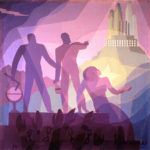
Colossal Youth (2006)
Dir. Pedro Costa
Nearly all of the press coverage of Colossal Youth has been accompanied by the same low-angle shot of Ventura, the film’s protagonist. He’s an elderly man, tall and thin. In this particular image, we see little of his face — just one eye peering over his right shoulder. The photo is dominated, instead, by the stark lines and sharp angles of a newly-constructed, State-funded tenement high-rise that blots out the sky behind him.
The image is even more striking in the film. Costa cuts first to the building, which hangs in space like a two-dimensional painted backdrop, and pauses there for a few seconds, allowing our eyes to adjust to the sudden brightness before Ventura enters the frame. I’ve probably seen that promotional photo fifty or sixty times since my first viewing of Colossal Youth in September, but Ventura’s entrance still shocked and surprised me on a second viewing. The light is so cool and clear and the contrast so high that all of the contours in Ventura’s black suit are lost and he is likewise rendered in two dimensions, iconic-like. Only his expressionless face has depth and shadow and, thus, appears “real.” When Ventura enters the frame and hits his mark, posing for Costa’s camera, the image is barely cinema at all. (When a friend asked why I like Colossal Youth so much, the best answer I could come up with was, “Because before seeing it, I didn’t know film could do that.”)
Less than 24 hours after seeing Colossal Youth again, I found myself in the DeYoung Museum, staring at Aaron Douglas’s “Aspiration” (1936). The day before I’d been struck by the notion that Costa’s film is a nostalgic (in the best sense of the word — “a painful yearning”) return to Modernism, and, in particular, a return to Modernism’s epistemological and political concern for form. And here, in the middle of Golden Gate park, hung a keen relic from that era. Commissioned for the Texas Centennial Exhibition, “Aspiration” fashions from the lines and angles of the “lone star” an allusion to America’s slave-trading past: the dark peaks created in the spaces between the two lower points of the stars recall the pyramids of Egypt, especially when juxtaposed against the reclining woman, a symbol of African civilization.
Moving from the bottom of the canvas (foreground) to the top (distance), “Aspiration” invokes the “progress” of African American history from slavery to emancipation to industrialization, but it does so in a manner (form) that generates tense ambivalence. Douglas’s shadowed, cut-out figures are sliced by the hard lines of the stars, and the new American “city on the hill,” with its art deco idealism, seems insurmountably distant (not to mention dehumanizing and exploitative). The title of the painting, like the image itself, must be read ironically, but not just ironically, for the work’s subject — the tragic, beautiful hope of African American experience — is urgent and potentially radical. (With shades of Walter Benjamin on Paul Klee’s “Angelus Novus”: “The storm drives him irresistibly into the future, to which his back is turned, while the rubble-heap before him grows sky-high. That which we call progress, is this storm.”)
Colossal Youth documents a specific instance of “progress” by following a small community of impoverished immigrants as they’re relocated from the Fountainhas district of Lisbon to Casal Boba, a suburban housing development. Fountainhas, which features prominently in Costa’s earlier films, Ossos (1997) and No Quarto de Vanda (2000), was razed during the filming of Colossal Youth. It simply no longer exists. Vanda Duarte and the rest of Ventura’s “children” have been removed permanently to those white tenement high-rises, where they enjoy relatively healthy living conditions and benefit from State-subsidized healthcare and social programs. (I make this assumption based on the worker who arranges Ventura’s apartment and Vanda’s story about taking methadone to battle her heroin addiction.)
The same tense ambivalence that characterizes “Aspiration” can be felt even in my brief summary of Colossal Youth. I’ve not yet seen No Quarto de Vanda (and, unfortunately, it will be the one Costa film still to have elluded me after I spend a long weekend in Toronto next month), but the Fountainhas that we see in Ossos is a dank and demoralizing place. A political reading of Colossal Youth that glosses over the practical benefits of Casal Boba would stretch the bounds of credibility. However, the verbs in my summary are key: “relocated” and “removed.” The people of Fountainhas are acted upon, and once personal freedom is eliminated from the equation, the State’s intent, no matter how good or just, loses relevance.
In other words, Colossal Youth, like Douglas’s painting, raises the sticky problem of agency. As we learn from Dave McDougall’s excellent piece on the film, Costa’s intent is to tell “the history that nobody has yet told,” the story of the immigrants of Ventura’s generation who were lost in the shuffle of Portugal’s revolutionary transformation in the mid-1970s from a dictatorship to a liberal democracy. “Filming these things the way I did does not put much faith in democracy,” Costa has said. “People like Ventura built the museums, the theaters, the condominiums of the middle-class. The banks and the schools. As still happens today. And that which they helped to build was what defeated them.” [Thanks, Dave, for the translations.] Costa’s words remind me of those who argue that, instead of conservatives or libertarians, it’s actually people of the far Left who should oppose social welfare programs, since those programs soothe the suffering that would otherwise provoke revolution. As Costa says in the same interview, Ventura’s “children” are also the lost children of April 25, 1974, whose potential revolutionary spirit has been dashed by the “white walls” of Casal Boba.
Which brings me back to that signature photo of Ventura and to Costa’s Modernism. After reading Dave’s post, it occurs to me that nostalgia might be a particularly useful concept in thinking about Colossal Youth. “There are two parts to this film,” Costa says, “a past and a present of the Fontaínhas, that coincide also with the before and the afterwards of the 25 of April. The past is fraternal, utopian, romantic. In this time is the story of the love-letter that Ventura repeats. The present is resigned, unfortunate, mediocre.” I suspect Costa might say the same of the cinema?
– – –
I’ll be seeing Colossal Youth again on June 16, and I’m hoping that Costa will make his appearance on that weekend. I plan to write a second installment of this piece after the retrospective.
-
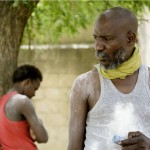
2007 SFIFF Capsules
A few notes typed at the end of a long flight home.
Daratt is The Son flipped on its axis, the story of a fatherless child whose justifiable desire for vengeance is tempered by grace and grief. A few key scenes are poorly executed and so aren’t quite as powerful as they should have been (the Dardennes would have hit them out of the park), but the film seems more impressive the more I think about it, thanks in large part to a final scene that is as perfectly structured, as surprising, and as satisfying as any I can think of.
Opera Jawa was simply an overwhelming experience for me. Full of images as powerfully imaginative as any you will find in Angelopoulos and late Kurosawa (I kept thinking of Ran), combined with a stunning gamelan score and dance sequences so strange and transcendent I expected Denis Lavant to make an appearance, this film has the effect of all great opera: it’s epic, sensuous, and impossibly beautiful.
A Few Days Later . . . Imagine Kiarostami’s aesthetic (long static takes, a fixation with winding roads) combined with the mise-en-scene, wit, and narrative tension of the typical American soap opera and you’ll get something like this film. I didn’t care for it.
At the Edge: New Experimental Cinema included a couple strong entries. Of the films I hadn’t already seen, Charlotte Price’s Discoveries on the Forest Floor, 1-3 were probably my favorite. As usual when I write about experimental film, I’m coming from a position of near-total ignorance, but Price’s short montages of extreme close-ups impressed me with their rhythm as much as their images. I also really liked Ken Jacobs’ Capitalism: Slavery, which cuts between the two halves of a 19th century stereoscopic photograph, suspending the depicted slaves, slavemaster, and field of cotton in a kind of endless exchange.
Forever, like Agnes Varda’s The Gleaners and I, is a lovely manifestation of its creator’s curiosity. During her pre-screening interview, Honigmann drew a distinction between her films and the work of most contemporary documentarians, claiming, “I don’t make films about subjects; they’re about people. Unless I love the person in front of my camera, I cannot film them.” In this case, she found in Paris’s Pere-Lachaise cemetery a usable metaphor for the fickle permanence of art. There, amidst the shrines to Chopin and Proust, she meets a collection of mourners and pilgrims whose rituals casually reveal the peculiar nature of loss. What makes the film such a success is Honigmann’s willingness to allow the people she meets to dictate the course of her essay. Rather than leading them with questions, she listens attentively, with curiosity, and not surprisingly most are eager to tell her their stories.
The Island begins like an Indiana Jones film and ends somewhere closer to Ordet. I shouldn’t have liked it nearly as much as I did, but the basic premise — a man devotes his life to back-breaking service in a community of monks as penance for his sin — worked for me, and the film is just clever enough, funny enough, and serious enough to avoid sentimentality.
Paprika was not the film I’d hoped it would be — that is, the film that would cure me of my anti-anime biases. The best I can say about it is that it is the product of an astounding imagination. But, at the risk of gettin’ all Bazinian, I’ve decided that I go to the cinema to see images of reality captured by a camera. (That foul smell you just noticed is the reek of my newly-opened can of worms.)
The Old Garden wasn’t the best film I saw at the fest, but it was definitely the most pleasant surprise. More coming . .
Private Fears in Public Places finishes strong, doesn’t it? When I saw it at TIFF I left early, thirty minutes or so before it transformed into a work of magical realism. Resnais, in his old age, has discovered images of such painful and beautiful melancholia, which are too rare in the cinema. By the time it ended, I cared deeply about every character in this film, another rare quality.
Fresh Air is straight out of the Kaurismaki school of expressionless faces, pregnant pauses, and coal-black humor. Agnes Kocsis, who was only twenty-five when she made the film, shoots mostly in master shots, stringing together dull moments in the life of a mother and daughter who long ago gave up on communicating with one another. Fresh Air reminded me also of Juan Pablo Rebella’s Whisky, which likewise ends about how you would expect it to but does so with a precise enough attention to detail and with a genuine enough concern for its characters that it all seems worthwhile. Another film with a strong final sequence.
Desperately Seeking Images was introduced by the program’s curator, who told us he doesn’t like grouping short films by “themes.” He might reconsider that strategy. The standout was Tube with a Hat by Radu Jude, who was assistant director on The Death of Mr. Lazarescu. I love the film’s premise — a boy begs his father to have their television repaired so that he can watch a Bruce Lee movie. The film follows them on their day-long journey.
Vanaja was a last-minute change in my schedule, and I still haven’t decided if it was a good move. I was angry with the film for most of its running time — movies that include child rape and dance numbers aren’t my cup of tea — but at my most charitable, I think Vanaja is an interesting subversion of the Cinderella fairy tale. Like an Angela Carter story (or a Thomas Hardy novel, even) it subjects its heroine to a string of trials with little hope of a happy ending. That it was such a crowd pleaser at the festival, though, confirms my initial impression that first-time director Rajnesh Domalpalli elided too much of the violence and failed to really subvert the genre at all. Truthfully, I’m still a bit angry with the film.
Dans Paris answers the question, “What would those early New Wave films — the ones made before Godard and the rest got all “political” — look like if they were made today?” It’s a fun film. Sexy, touching, with a great score. I liked it a lot.
-

The End and the Beginning (2006)
Dir. Eduardo Coutinho
“We want to hear stories,” director Eduardo Coutinho says early in this film, which is built almost entirely from interviews he conducted over a two-week period in Paraiba, a backlands town in in the northeast of Brazil. Specific stories. Intimate, personal stories. Ten minutes or so into the film, as a man in medium close-up describes the hard circumstances of his life, Coutinho drowns him out with his own voice-over narration, informing us that this story won’t do, that it lacks the “closeness” he’s seeking. And so, with the help of Rosa, his young guide, he focuses instead on the community where she lives, a small network of aged kin who’ve given their lives to the hard land they live on.
Many of the people Coutinho interviews inhabit the same homes where they were born six, seven decades earlier. Their skin is hard and deep-lined, and their stories are similar: each began a life of labor during childhood, only a few received a formal education; there were marriages (most of them successful, or so they say) and many, many pregnancies. We learn about all of this from their lively, impassioned, and occasionally bitter remembrances. Coutinho, we discover in a surprising two-shot near the very end of the film, sits quite close to his interviewees (typically, they’re framed in tight close-ups), earning their trust and fondness.
Very much like a film I saw here at SFIFF two years ago, Raymond Depardon’s Profiles of Farmers: Daily Life, The End and the Beginning is, in Coutinho’s words, “a tale of a life that is rapidly disappearing.” Frankly, I remember almost nothing of Depardon’s film, but I suspect Coutinho’s will linger with me for quite a while, partly due to the charm of his subjects, but also because, in acknowledging its position as a work of documentary — the first words of the voice over tell us that the film “began from scratch”; the crew simply drove out of Rio de Janeiro and showed up in Paraiba — The End and the Beginning also serves as a kind of test case, giving a media(ted) voice to people who have never had one before but never pretending that such mediation is without moral and political consequence.
When Coutinha returns to each of his interviewees to say a final goodbye, there is genuine sadness in their faces (or at least in the faces that made the final cut). Earlier, one man in particular had expressed misgivings about appearing on camera, saying that he felt his words would be spoken “in vain.” When Coutinha asks him what he means, he says, “a word in vain is a word with no future.” The line resonates throughout his final on-camera appearance. In the intervening days he’s apparently thought a great deal about filmmaking. He suggests, even, that Coutinho shoot him from a different angle, then he laughs, and instantly we imagine him alone in front of a mirror, turning and looking through the corners of his eyes at his right profile then the left and back again. Given an opportunity, finally, finally, to tell his story, he regrets that the chance has passed so quickly. “You’re a smart and interesting man,” Coutinho tells him. “I have more to tell,” he says.
-

SFIFF 2007
I’ve resigned myself to a life in the suburbs, but the older I get, the more frequently I’m overcome by a traveling Jones. So when Michael graciously offered me a place to stay, I jumped at the chance to spend a week roaming the hills of San Francisco and watching some great films. This will be my second trip to SFIFF, and I’m really excited about my lineup. I’ll get a second shot at a few TIFF favorites (Colossal Youth and Private Fears in Public Places), I’ll get to see a couple that I missed the first time around (Daratt, Opera Jawa, and The Island), and, of course, there will be several new discoveries. I’m especially excited about Forever, the latest from Heddy Honigmann, who will be in town to receive the Golden Gate Persistence of Vision Award.
- The End and the Beginning (Coutinho)
- Daratt (Haroun)
- Opera Jawa (Nugroho)
- A Few Days Later . . . (Karimi)
- Colossal Youth (Costa)
- At the Edge: New Experimental Cinema
- Forever (Honigmann)
- The Island (Lounguine)
- Paprika (Kon)
- The Old Garden (Im)
- Private Fears in Public Places (Resnais)
- Fresh Air (Kocsis)
- Desperately Seeking Images
- Stories from the North (Raksasad)
- Dans Paris (Honore)
-
Mix CD: It’s Beautiful Now
A month or two ago, a guy at work invited me to join his “prayer meeting.” For those of you who’ve never ventured south of the Bible belt or who didn’t grow up Baptist, prayer meeting is where a good number of church folk spend their Wednesday evenings. It’s a time of fellowship and support and meditation (though in my experience most who attend would bristle at that word, meditation, which reaks of godless Eastern religion and, frankly, hippies). But anyway . . .
Our prayer meeting is held at Preservation Pub, which boasts a distinct advantage over most official houses of prayer in that it pours cheap pints of Guinness and Smithwicks. Also, it has a killer jukebox and a poster of Woodie Guthrie playing his “This Machine Kills Fascists” acoustic guitar. The Pub is on Market Square, just a few doors down from where Suttree goes to sell his fresh catch, and it feels good and old inside.
So on most Wednesdays now I head straight from work to the Pub, where I meet up with an always-different assortment of
interesting characters, many of whom have been meetin’ together like this for years. And then, a pint or four later, a small group of us grab our instruments and walk a few blocks to a downtown office, where we hack and sing our way through the Neil Young, Bob Dylan, Everly Brothers, The Band, and Pink Floyd songbooks. Last night I discovered, proudly, that I know every word to “Wish You Were Here” and can sing it, too.I made this mix for the other guys at prayer meeting, nearly all of whom are about a half-generation older than I am. We all grew up listening to the same music, though. They bought vinyl in the new releases bin; I saw the reunion tours. Roughly, the guidelines for the mix were:
- Music they’d like.
- Music released during the last five years.
- Music from albums that I could strongly recommend.
I made a couple exceptions on guideline #2 but I think they’re justifiable. A friend listened to the mix and told me it sounded like an anthology of mellow songs of the ’70s, which I take as a mark of success. As usual, if you want a copy, send me your snail mail address (or leave a comment). I’d love something in return but it’s not expected.
Side 1
1. “Cold Roses” by Ryan Adams, from Cold Roses (2005)
2. “So It Goes” by Anders Parker, from Tell It To the Dust (2004)
3. “The Race is On Again” by Yo La Tengo, from I Am Not Afraid of You and I Will Beat Your Ass (2006)
4. “A Good Man is Hard to Find” by Sufjan Stevens, from Seven Swans (2004)
5. “Feel You Now” by The Autumn Defense, from The Autumn Defense (2007)
6. “Tampa to Tulsa” by The Jayhawks, from Rainy Day Music (2003)
7. “Theologians” by Wilco, from A Ghost is Born (2004)
8. “Water Ban” by The Pernice Brothers, from Yours, Mine & Ours (2003)
9. “Stacked Crooked” by The New Pornographers, from Twin Cinema (2005)Side 2
10. “Living Proof” by Cat Power, from The Greatest (2006)
11. “Glenn Tipton” by Sun Kil Moon, from Ghosts of the Great Highway (2003)
12. “Roscoe” by Midlake, from The Trials of Van Occupanther (2006)
13. “Effigy” by Uncle Tupelo, from 89/93: An Anthology (1993)
14. “House Carpenter” by Oakley Hall, from Gypsum Strings (2006)
15. “The Past and Pending” by The Shins, from Oh, Inverted World (2004)
16. “Black Star” by Radiohead, from The Bends (1995)
17. “Black Star” by Gillian Welch & David Rawlings, from Black Star EP (2004)
18. “Broken Chair” by Luna, from Rendezvous (2005) -
What Are You Reading?
Following Girish’s lead . . .
Love is a Mix Tape by Rob Sheffield — I picked up a copy of Love is a Mix Tape after reading and really enjoying Fluxblog’s three–part interview with Sheffield. His book is a memoir of sorts. In the late-’80s, while a grad student in UVA’s English department, Sheffield met Renee, another music-obsessed writer. The two bonded over Big Star (“Thirteen” was the first dance at their wedding) and spent most of the next decade together. Then, suddenly and impossibly, Renee died. Maybe it’s because I’m so much like Sheffield — a book dork who spent too much of his life alone in his room listening to music before meeting a fiery Southern girl who (warning: cliche ahead) taught him how to love — but I ate this book up.
Suttree by Cormac McCarthy — This is how cool the office where I work is: When I sent out an email suggesting that we start a reading group — an excuse to drink a few beers and enjoy the spring weather after work, really — and when I suggested that we start with Suttree, McCarthy’s Knoxville novel, nearly fifteen people jumped on board. At least one of them has already backed out (those first few pages are work, man), but I’m hoping a few of us will make it all the way through. I’ve decided that the idea for this little project came as a prompt from my subconscious, reminding me of the impending one-year anniversary of my escape from academia. I’m finally eager to read and discuss serious fiction again.
Oldman’s Guide to Outsmarting Wine by Mark Oldman — From now on, whenever anyone I know expresses even the slightest interest in learning more about wine, I’m going to send them a copy of Oldman’s book. It’s a collection of “108 shortcuts” and reads like something from the For Dummies series, except that it’s witty, practical, and genuinely informative.
Experimental Film Books — 2007 is my experimental film year, so I’ve been reading all around the subject, trying my best to coordinate the growing stack of books with my Netflix and GreenCine queues. After reading a bit about The War Game in Amos Vogel’s Film as a Subversive Art, I dove into Peter Watkins’ films. Which in turn led me to the interview in Scott MacDonald’s A Critical Cinema Vol. 2. And since that book also includes a conversation with Ross McElwee, I rented all of his films I hadn’t already seen. (Time Indefinite is so great, I cried.) And then that Kenneth Anger DVD collection came out, so I pulled out my copy of P. Adams Sitney’s Visionary Film, wich I’ve been dipping into as well.
Yasujiro Ozu Books — 2007 is also my Ozu year. I have a massive pile of films to watch and almost as many books. I’ve read about 30 pages each from David Bordwell’s Ozu and the Poetics of Cinema and Donald Richie’s A Hundred Years of Japanese Film and Ozu.
-
That Narrative Drive
Eye tracking technology now allows us to create “heat maps” of visual spaces. It’s of particular use to those of us with an interest in website layout and navigation. The image above is from a recent study that compares the markedly different ways that psychologists (left) and artists (right) look at photographs:
So why do artists look at pictures — especially non-abstract pictures — differently from non-artists? Vogt and Magnussen argue that it comes down to training: artists have learned to identify the real details of a picture, not just the ones that are immediately most salient to the perceptual system, which is naturally disposed to focusing on objects and faces.
Related:
The main problem with narrative in film is that when you become emotionally involved, it becomes difficult to see picture as picture. Of course, the laughing and crying and suspense can be a positive element, but it’s oddly nonvisual and gradually destroys your capacity to see.
— Michael Snow, speaking to Scott MacDonald, A Critical Cinema, Vol. 2 -
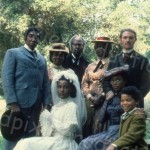
The Politics of Form
Peter Watkins in a 1981 interview with Scott MacDonald (A Critical Cinema vol. 2), discussing the television miniseries Roots (if the quote seems jerky and repetitive, it’s because I mashed together snippets from several pages):
It’s pukemaking. I really can’t look at a narrative film anymore — not one with these traditional rhythms going on. The manipulation is so patent. . . . I would go so far as to say that to put the black experience into a conventional narrative structure is racist. Because you are feeding into a language that neutralizes it. How many people say, “I can’t even remember the film I saw last night.” You put the slave experience through the same rhythms as Kojak and Love Story and . . . well, I think that’s a real problem now. . . . In Roots, you’re given a seemingly bleak or radical look at history, which in fact isn’t at all because you’re swimming along in this warm reassuring Jell-O: the narrative form in which it’s given to you. . . . The point that I keep trying to hammer home these days is not only that the ideas on TV are conservative, but that the form with which they’re presented (even if there were ideas with which you and I might politically agree) defuses them.
-
The Day Job (Part 2)
Redesigning the UT Knoxville front page was the first step in an on-going overhaul of the university’s web presence. Step two went into effect today, when I officially released the design template for all colleges, departments, and units. Conceptually, this design was actually the greater challenge — much to my surprise. Our priorities went something like this:
- Carry through the same brand identity that was established with the front page redesign, but do so in a way that draws subtle but significant distinctions between the two web spheres.
- Aspire for full web standards compliance, while acknowledging — and even embracing — the fact that we’ll never be able to properly “police” the code. As I wrote in the documentation, “I’m betting that it will take less than three weeks before we find a live template page that has been completely rebuilt with nested tables.” And I’m okay with that.
- Strike a deliberate balance between consistency (of design, brand, and navigation) and freedom. UT has eleven colleges and more than 300 degree programs, not to mention the hundreds of academic institutes, administrative offices, outreach centers, research initiatives, and support units. Each has a unique audience and unique goals; each should look like it contributes directly to the university’s overarching mission.
- Make this transition as painless as possible for the community of web developers across campus who will have this template dropped in their laps. Inheriting someone else’s code always sucks. I did my best to streamline it, to predict and prepare for eventual problems, and to comment the heck out of the code. We also decided to provide developers with a toolbox of menus and design ideas. If, in the process, we also manage to foster a more collegial attitude among campus web professionals, so much the better.
-
March Madness Pick ‘Em
Andy beat me to the punch by a couple days, but for those of you who spend too much time alone in dark rooms watching moving pictures, let me remind you that the next three weeks are the most exciting of the year for many American sports fans. It’s league championship week, followed immediately by the High Holy days of the NCAA tournament.
I’ve created a group at Yahoo Sports (the “Dziga Vertov Group,” naturally) and invite all interested parties to join the fun. Fill out your bracket, then test your mettle against other film bloggers and Long Pauses readers. If you want to play, leave your email address in the comments or drop me a private note, and I’ll send you the group number and password.
Note: Not by coincidence, the question mark at the center of this bracket is Tennessee orange. I don’t really expect them to win it all, but the Volunteers will be in the Sweet Sixteen. (I’m saving my National Championship prediction for next year.)
Update: We already have nine players in our group. The more the merrier. Selection Sunday is March 11. Registration ends on March 15, before the start of the first game.
-
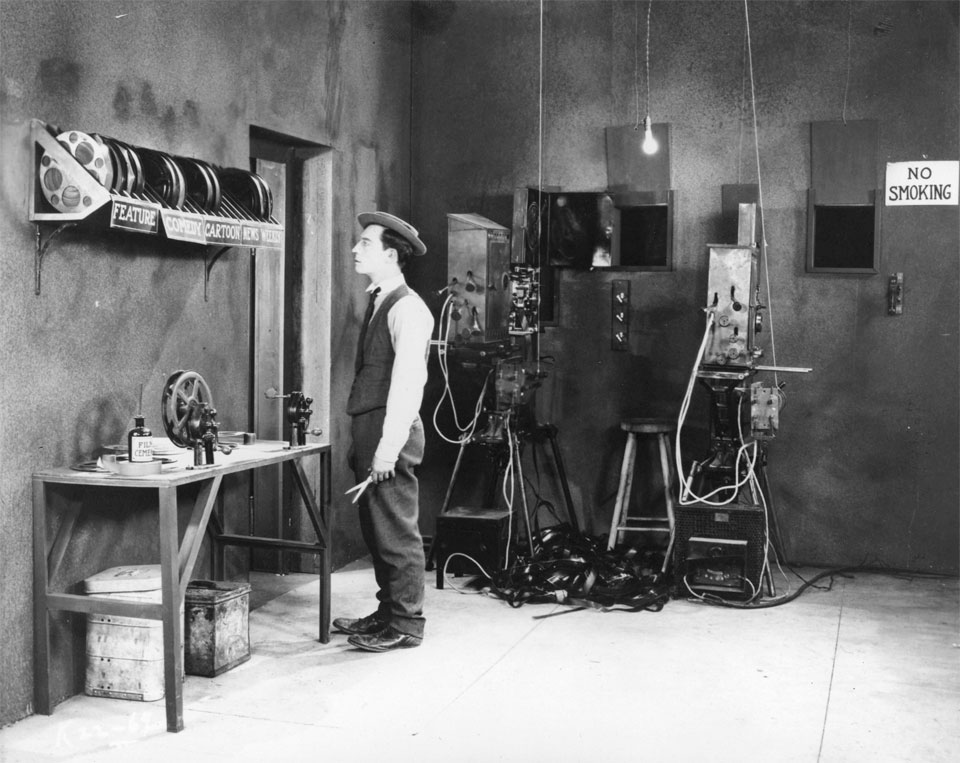
My Favorite Films (2007 Edition)
Inspired by a recent re-viewing of Sherlock, Jr. . . .
According to Your Movie Database, I last compiled a list of my 20 favorite films almost exactly four years ago. I’ve seen nearly 700 more since then, so I thought it was time to give it another go.
I’ve stuck to the “one film per director” rule. Otherwise, there might be a couple more from Hal Ashby (The Last Detail, Shampoo), Claire Denis (I Can’t Sleep, The Intruder), Richard Linklater (Before Sunrise/Sunset), Andrei Tarkovsky (Andrei Rublev), and Carl Dreyer (The Passion of Joan of Arc). The most difficult decision was singling out a Godard film. I have strong favorites from each of his periods but none stands clearly above the rest. Please don’t ask me to justify my choice. I can’t.
The list hasn’t actually changed as much as I’d expected. A few of the big names (Bergman and Bresson) have dropped in rank. A few others dropped off completely (Kieslowski, Egoyan, Dumont, Coppola, and Anderson). And a few sentimental favorites made the cut despite my changing tastes. I would no longer list Hitchcock and Kubrick among my favorite directors, for example, but had I never seen Rear Window and 2001 I wouldn’t be a cinephile today. Pedro Costa’s Ossos comes in at number 20 because, of the films on the list, it’s my most recent discovery. We’ll see if it’s still there in four years. I guess I should be surprised (or at least apologetic) about having chosen nine films made since 1990, but I’m not. I am a bit embarrassed by the total lack of Japanese films, which makes me think I need to spend more time with them.
- Mirror (Andrei Tarkovsky, 1975)
- Beau Travail (Claire Denis, 1999)
- Dazed and Confused (Richard Linklater, 1993)
- The Son (Jean-Pierre and Luc Dardenne, 2002)
- Faces (John Cassavetes, 1968)
- Sherlock, Jr. (Buster Keaton, 1924)
- Ordet (Carl Dreyer, 1955)
- Harold and Maude (Hal Ashby, 1971)
- The Best Years of Our Lives (William Wyler, 1946)
- 2001 (Stanley Kubrick, 1968)
- What Time Is It There? (Tsai Ming-liang, 2001)
- Good Men, Good Women (Hou Hsiao-hsien, 1995)
- Rear Window (Alfred Hitchcock, 1954)
- In the Bathtub of the World (Caveh Zahedi, 2001)
- Pather Panchali (Satyajit Ray, 1955)
- Close Up (Abbas Kiarostami, 1990)
- Cries & Whispers (Ingmar Bergman, 1975)
- Au Hasard Balthazar (Robert Bresson, 1966)
- In Praise of Love (Jean-Luc Godard, 2001)
- Ossos (Pedro Costa, 1997)
-
Why Hillary Ain’t on My Short List
I’m in a quoting/linking mood today. From a great post at Daily Kos:
The question, Senator Clinton, is have you learned anything? Have you learned that to authorize war is always a last resort, not a first, or seventh, or seven times seventh. Have you learned that it’s not okay to allow fear — including fear for your career in politics — to herd you along with the crowd. Have you learned that good judgment isn’t just avoiding error. It’s acknowledging that an error has been made and working promptly to correct it.
-
Why It’s Been So Quiet Around Here
My office at work is fairly small. Windowless. Tidy. Lit by three underpowered lamps. Spartan. The back wall is dominated by a large dry-erase board that, for the past four months, has been covered in brown scribbles, which is a kind way to describe my handwriting. Sometime back in the fall I wrote myself a long to-do list on the board, and in the weeks since I have slowly but steadily crossed off each item. A brown stroke through each brown scribble. On Wednesday morning, just before 7 am, I erased the board.
Or maybe this is a better way to begin . . .
Back in July, when I attended the Seattle Web Design World conference, a woman with whom I was having a nice enough conversation, gave me the most pitiable look when I told her why I was there.
“I was just asked to redesign the University of Tennessee homepage, and I’m looking for any help I can get.”
“Really? [pitiable look] I’m so sorry. [pause] Good luck with that.”
Most high-traffic websites serve a very specific function. No matter how much it continues to evolve, for example, Amazon still sells things, and so its chief concern is getting its users as quickly as possible to that thing they want to buy, while also showing them other things along the way that they didn’t know they wanted to buy. A university homepage is a design nightmare because it must simultaneously address the distinct (and often competing) purposes of its many and varied audiences. For the sake of simplicity, I’ll divide them into two camps: those within the institution (administrators, faculty, staff, and students) and those outside of it (prospective students and their parents, alumni and donors, legislators, people in the surrounding community, sports fans, business and research partners, journalists and media, other educators and scientists and institutions, people with an interest in culture and the arts, job-seekers and employers, and the list goes on and on). The site must also be navigable, which, relatively speaking, is the easy part.
Previous incarnations of the University of Tennessee website were very efficient, particularly in regards to navigation, but they didn’t “tell the UT story.” Taking that as our cue, we looked to the standard university menu buttons — Future Students, Faculty & Staff, Academics, etc. — as themes or chapters in an anthology. Rather than simply compiling lists of links, we’re now using those pages to spotlight people, events, and resources from the university community. I kept imagining a user who knew little about the university — a high school junior taking her first peek into college life, a researcher in China mulling over his post-doc options, a new Knoxvillian trying to figure out where we’ve hidden all the culture — and my hope was that, by clicking on each of those main menu buttons and watching the spotlights rotate through, he or she would get a good sense of what the university has to offer.
There were other design challenges particular to UT Knoxville, the most significant of which is this:
which I toned down slightly:
and which, in predictable web 2.0 fashion, soon became:
Accepting a web design position at a university means surrendering whole swaths of the color palette. For those of you not acquainted with college athletics in the States, the University of Tennessee Volunteers are also known as “The Big Orange.” Orange is not just our signature color; it’s our only color. To make matters even more complicated, the blues and purples that naturally compliment orange are completely off-limits. Why? I bet the sports fans know. Mixing orange with light blue makes us look like Florida; dark blue drifts into Auburn territory; and purple is Clemson’s secondary color. So orange it is. And a lot of it. We settled on a “blue sky” campus photo for the header, which is a bit of cheat, but an effective one, I think.
Another significant complication was the UT wordmark, which was a mandated element of the university system’s larger branding initiative:
It’s an elegant and traditional wordmark that employs an elegant and traditional serif font (Goudy Old Style). It looks great on business cards, letterhead, and signage. It doesn’t looks so good on the web, where the delicate vertical and horizontal lines in each letter inevitably bleed and lose their contrast. With a limited palette to work with (“Did you try setting it against an orange background? I bet that would make it really pop!”), I settled on gradiated shades of grey. It was the best of several less-than-satisfying options.
Some of the other major changes:
- The site is web standards-compliant and displays properly in IE 6. (Thanks to Jason for all of the debugging help.)
- We’ve integrated a campus events calendar into the site and are using it to create and broadcast audience-targeted RSS feeds.
- Using tracking data, I’ve restructured the subpage navigation to give greater prominence to the most popular links (Quick Links) and to bury the least popular (see the “expand the full list” link near the bottom of the Current Students page, for example).
All in all, I have to say I’m pretty damn proud of it.
-
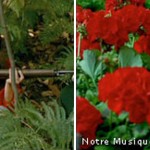
Godard’s “Paradise”
A throwaway observation: The many reviewers who have described act 3 of Notre Musique as “pastoral” and “lyrical” are projecting their own desires onto it. After watching 25 Godard films in the last few weeks, I can think of very few sequences that take place completely in nature. In fact, the only two stand-outs are the interview with Eve Democracy in One Plus One and the final act of Weekend. Godard’s characters often leave the city — see Les Carabiniers, Pierrot Le Fou, and For Ever Mozart — but they always maintain access to a car or some other technological connection to civilization. (Now that I think about it, even Miss Democracy is always accompanied by that interviewer and camera crew.) Weekend, then, is Godard’s paradigmatic expression of nature as revolutionary and savage; Notre Musique‘s “Paradise” is, likewise, a political and ironic space.
-

By the Time It Gets Dark
First great show of 2007: Lambchop and Yo La Tengo. Unfortunately, YLT’s last visit to Knoxville was memorable for reasons having little to do with the amazing music that was played that night. But they came back anyway, God bless ’em, and this time they played to a large and rapt audience at the Bijou. They closed the show with this cover of the old Sandy Denny song, “By the Time It Gets Dark,” and I’ve probably listened to it a hundred times since. And I have to mention this: thanks to the kindness of a friend, I not only got to hang out with Georgia for a while and drink a beer from the YLT stash; I actually drove Georgia and Ira’s van. That smell you smell is indie rock cred. I reek of the stuff.
-
YouTube (Instead of) Memory
I hope to have a real post up in the next day or two, but until then here’s an odd clip I just stumbled upon. I witnessed that exact event after stepping out of a film at TIFF this year. It was in the Paramount Theater, at the top of the long escalators. And now I no longer need to remember it. My memory has been captured, uploaded, tagged with metadata, and stored safely away, where it can be retrieved immediately — by anyone. And I played no part in the process.
-
I Think I’m in Love
Jim Webb during his first hearing with the Armed Services Committee:
I also want to say something about my longtime friend, Senator McCain’s comments when he was talking about the consequences of pulling out of Iraq and in your statement, Secretary Gates, you list some of these as an emboldened and strengthened Iran, a base of operations for jihadist networks in the heart of the Middle East, an undermining of the credibility of the United States.
In many ways, quite frankly, those have been the results of the invasion and occupation. There’s really nothing that’s occurred since the invasion and occupation that was not predictable and in fact, most of it was predicted. It was predicted in many cases by people with long backgrounds in national security…and in many cases there were people who saw their military careers destroyed and who were personally demeaned by people who opposed them on the issues, including members of this administration. And they are people in my judgement, who will be remembered in history as having had a moral conscience.
-
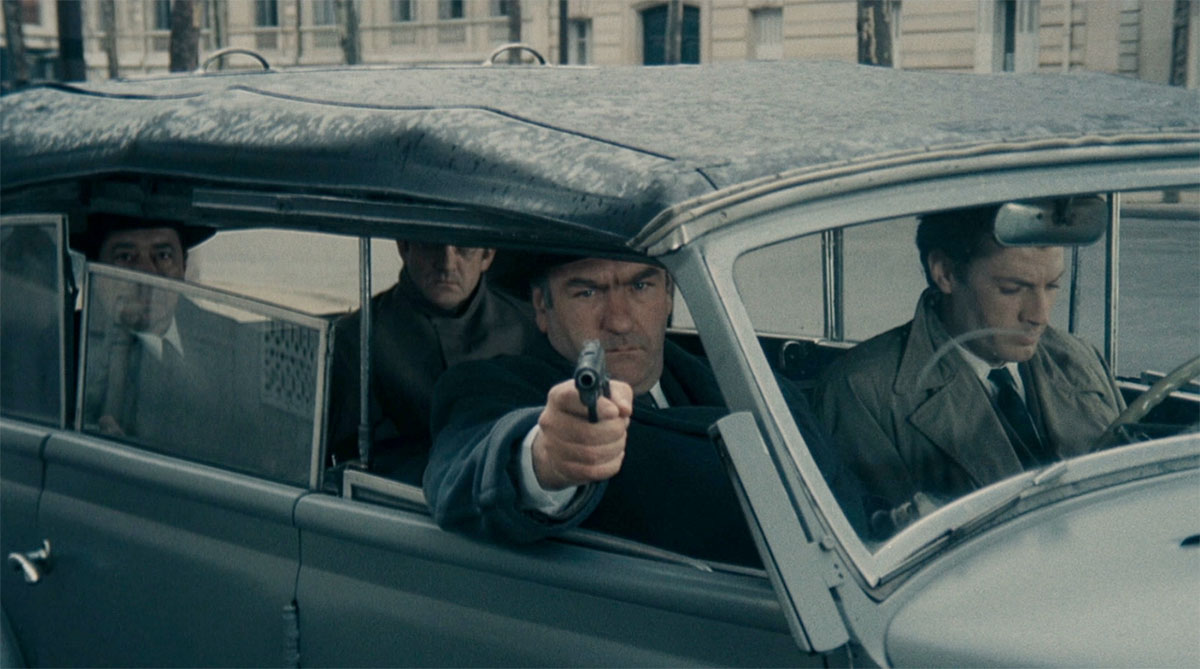
2007 Film Diary
January 1 Army of Shadows [Melville] 3 Several early Edison films 6 Casa de Lava [Costa] 7 Ossos [Costa] 14 Slow Motion [Godard] 15 Ossos [Costa] 17 Entr’acte [Clair] 17 La Coquille et le Clergyman [Dulac] 17 Anemic Cinema [Duchamp and Ray] 17 Ballet Mecanique [Leger] 20 Prenom Carmen [Godard] 27 Book of Mary [Mieville] 28 Hail Mary [Godard] 28 Modern Times [Chaplin] February 3 In Praise of Love [Godard] 4 Notre Musique [Godard] 8 Keep Your Right Up [Godard] 10 Fireworks [Anger] 10 Puce Moment [Anger] 10 Rabbit’s Moon [Anger] 11 Eaux d’Artifice’ [Anger] 11 Inauguration of the Pleasure Dome [Anger] 15 Sherlock, Jr. [Keaton] 17 Waxworks [Leni] 18 The Cat and the Canary [Leni] 22 Bodou Saved from Drowning [Renoir] 24 Piccadilly [Dupont] March 1 The Only Son [Ozu] 4 Talladega Nights [McKay] 6 It Happened One Night [Capra] 10 Days of Youth [Ozu] 11 Backyard [McElwee] 11 Charleen [McElwee] 12 Punishment Park [Watkins] 13 The Forgotten Faces [Watkins] 16 Funny Ha Ha [Bujalski] 17 Dragnet Girl [Ozu] 17 Time Indefinite [McElwee] 17 An Inconvenient Truth [Guggenheim] 18 Passing Fancy [Ozu] 20 Titicut Follies [Wiseman] 24 Edvard Munch [Watkins] 25 It Happened Here [Brownlow and Mollo] 26 Six O’Clock News [McElwee] 27 High School [Wiseman] 31 The War Game [Watkins] April 1 Culloden [Watkins] 7 La Commune, Part 1 [Watkins] 8 La Commune, Part 2 [Watkins] 10 Primary [Drew] 15 The Gladiators [Watkins] 15 Salesman [Maysles, Maysles, and Zwerin] 16 Don’t Look Back [Pennebaker] 24 Shampoo [Ashby] 29 The End and the Beginning [Coutinho] 30 Daratt [Haroun] 30 Opera Jawa [Nugroho] 30 A Few Days Later . . . [Karimi] May 1 Colossal Youth [Costa] 1 Destiny Manifesto [Colburn] 1 Capitalism: Slavery [Jacobs] 1 Interplay [Todd] 1 Atlantis Unbound [Hiris] 1 Watercolor Night Montage No. 7 [Clipson] 1 Discoveries on the Forest Floor, 1-3 [Pryce] 1 Forever [Honigmann] 2 The Island [Longuine] 2 Paprika [Kon] 3 The Old Garden [Im] 3 Private Fears in Public Places [Resnais] 3 Fresh Air [Kocsis] 4 Making the Balkans Erotic [Abramovic] 4 Strip Show [Brodie and Derewlany] 4 Dear Bill Gates [Christman] 4 Waiting for Yesterday [Lecat and Pioutaz] 4 Greyhounds [McKeever] 4 Tube with a Hat [Jude] 4 We Are Everywhere [Suinaga] 4 Woman and Gramaphone [Nilsson and Simonsson] 4 Vanaja [Domalpalli] 4 Dans Paris [Honore] 11 Old Joy [Reichardt] 13 The Ties That Bind [Friedrich] 22 Paris, Texas [Wenders] 26 Fine Dead Girls [Matanic] 27 Mutual Appreciation [Bujalski] 27 Fast Food Nation [Linklater] 29 Six Men Getting Sick (Six Times) [Lynch] 29 The Alphabet [Lynch] 29 The Grandmother [Lynch] 29 The Amputee [Lynch] 29 The Cowboy and the Frenchman [Lynch] 29 Lumiere [Lynch] June 2 Another Man’s Garden [Sol de Carvalho] 3 Regular Lovers [Garrel] 15 Johnny Guitar [Ray] 16 Sicilia! [Straub and Huillet] 16 O Sangue [Costa] 16 Colossal Youth [Costa] 23 Of Love and Eggs [Nugroho] 24 Virgin Stripped Bare by Her Bachelors [Hong] 24 Twin Peaks: Fire Walk With Me [Lynch] 30 Dam Street [Yu] 30 Wild at Heart [Lynch] July 1 The Elephant Man [Lynch] 2 Eraserhead [Lynch] 7 Irma Vep [Assayas] 7 They Live By Night[Ray] 10 Blue Velvet [Lynch] 13 Songs from the Second Floor [Andersson] 14 Last Life in the Universe[Ratanaruang] 16 Harry Potter and the Order of Phoenix [Yates] 19 Mulholland Drive [Lynch] 20 Ma Mere [Honore] 23 On Each Side [Grosso] 25 Cat People [Tourneur] 27 Chronicle of Anna Magdalena Bach [Straub and Huillet] 28 Oasis [Lee] August 2 Out of the Past [Tourneur] 5 The Leopard Man [Tourneur] 11 Iraq in Fragments [Longley] 12 The Straight Story [Lynch] 16 Zodiac [Fincher] 20 The Tree of Wooden Clogs [Olmi] 28 Night of the Hunter [Laughton] September 6 Persepolis [Paronnaud, Satrapi] 7 Fengming, A Chinese Memoir [Bing] 7 Le Voyage du Ballon Rouge [Hou] 7 POOL [Fui] 7 What the Water Said, nos. 4-6 [Gatten] 7 At Sea [Hutton] 8 Mourning Forest [Kawase] 8 The Man from London [Tarr] 8 Useless [Jia] 8 Europa 2005, 27 Octobre [Straub, Huillet] 8 Capitalism: Slavery [Jacobs] 8 Proft Motive and the Whispering Wind [Gianvito] 8 All That Rises [Saito] 8 Cross Worlds [Fontaine] 8 The Acrobat [Kennedy] 8 Echo [Pruska-Oldenhof] 8 The Butterfly in Winter [Aurand, Lang] 8 Monica [Mandirola] 9 XXY [Puenza] 9 Secret Sunshine [Lee] 9 In Memory of Myself [Costanzo] 9 Quartet [Hamlyn] 9 Erzahlung [Schupbach] 9 gone [Goldt] 9 The Anthem [Weerasethakul] 9 Schindler’s Houses [Hauser] 10 No Country for Old Men [Coens] 10 Encarnacion [Berneri] 10 Elizabeth: The Golden Age [Kapur] 10 Faux Movements [Chodorov] 10 Tape Film [Kennedy] 10 ecp 2D: sun [Price] 10 Discoveries on the Forest Floor [Pryce] 10 Papillon [Fouchard] 10 Evertwo Circumflicksrent…Page 298 [McClure] 11 Silent Light [Reygadas] 11 Contre Toute Esperance [Emond] 11 Naissance des Pieuvres [Sciamma] 12 Une Vieille Maitresse [Breillat] 12 Redacted [De Palma] 12 Dans la Ville de Sylvie [Guerin] 13 Paranoid Park [Van Sant] 13 Help Me Eros [Lee] 13 Wolfsbergen [Leopold] 13 L’Amour Cache [Capone] 14 Les Amours d’Astree et de Celadon [Rohmer] 14 Dans la Ville de Sylvie [Guerin] 14 One Hundred Nails [Olmi] 14 Les Bons Debarras [Mankiewicz] 15 La Fille Coupee en Deux [Chabrol] 15 Avant Que J’oublie [Nolot] 15 Ne Touchez pas la Hache [Rivette] 15 My Winnipeg [Maddin] 23 Eastern Promises [Cronenberg] 30 A Real Young Girl [Breillat] October 2 Munyurangabo [Chung] 7 36 Fillette [Breillat] 14 Perfect Love [Breillat] 15 Casa de Lava [Costa] 20 The Passion of the Christ [Gibson] 21 Romance [Breillat] 22 Casa de Lava [Costa] 23 The 400 Blows [Truffaut] 27 Ossos [Costa] November 1 Ossos [Costa] 4 In Vanda’s Room [Costa] 11 Fat Girl [Breillat] 13 What Time is it There? [Tsai] 14 Scorpio Rising [Anger] 14 Inland Empire [Lynch] 16 My Second Brother [Imamura] 17 Harry Potter and the Order of the Phoenix [Yates] 21 Reading Ossie Clark [Blake] 21 Sodium Fox [Blake] 21 Glitterbest (Unfinished) [Blake] 24 Sex is Comedy [Breillat] 28 A Man Escaped [Bresson] December 1 Brief Crossing [Breillat] 2 I’m Not There [Haynes] 10 Knocked Up [Apatow] 11 Masculin/Feminin [Godard] 12 I’m Not There [Haynes] 15 Anatomy of Hell [Breillat] 16 Lady Chatterley [Ferran] 18 Quinoa [Lynch] 19 Inland Empire [Lynch] 22 The Host [Bong] 28 Sweeney Todd [Burton] 30 In Vanda’s Room [Costa] -

Best Films of 2006
I’ve been debating for the last few days what I should write about in my year-end film post — wondering, frankly, if a write-up was necessary at all — and I’ve decided that the source of my ambivalence is the presence of so many similar lists and accompanying essays already out there. And that, I’ve just realized, is the real film story of 2006: the coming-of-age of online criticism. (See? Time magazine was right. We are the People of the Year.)
Not too long ago my twenty-link selection of “Daily Reads” constituted a near-complete list of the quality, regularly-updated websites that focused on world cinema. Now, with established print critics moving online and new voices chiming in everyday, I feel overwhelmed by the sheer volume of writing that greets me each time I open Bloglines — so much so that, to be honest, I’ve fallen out of the habit of reading much of it at all. I find that I now approach the film blog-o-sphere in much the same way that I would behave if we all gathered face-to-face for a massive cocktail party. I grab my drink and find a quiet table over in the corner where I chat with the folks I’ve known the longest and the best and whose tastes are most similar to my own.
All of this is good news in every respect, I suppose, but one: As the film blog-o-sphere has evolved, I’ve felt my relation to Long Pauses change as well. Strange as it is to say, I feel a greater pressure these days to make declarations, to take a side, to join in “the critical conversation.” That bloggers now have a legitimate (or legitimated [by marketing departments]) voice in that conversation blows my mind. But, as anyone who has festival’d with me can tell you, making declarations and shaping consensus is the last reason I started writing these “responses” six years ago. Which is why I found it so odd to find myself thinking recently, “I really need to see A Prairie Home Companion, When the Levees Broke, and those Scorsese and Eastwood films.” I needed, in other words, to make my Top 10 “count.” Strange.
The tenor of this post might imply that I have a deep stake in the debates about the current state of film criticism. I don’t. Or, at least, I think I don’t. I’m genuinely grateful for the film blog-o-sphere, for the close friendships that have developed because of it, and for the remarkable resource it has become. It’s exciting. To continue the analogy, the cocktail party’s warming up and the room is getting noisy. But I’m a hopeless introvert, and crowds make me anxious.
But anyway, here are the obligatory lists. The top three films (I count Jia’s two films as halves of a whole) are as great as anything I’ve seen since The Son, and the rest of the top 15 (yes, I needed 15 this year) are all fantastic as well. I can’t wait to watch Syndromes and Century and Colossal Youth again. Both are crammed full of beauty and mystery, and I’m eager to reexperience their magic. I forced myself to order the list this year and was surprised by the rankings. So Yong Kim’s remarkable debut, In Between Days, climbed a notch or two higher with each revision, as did Marc Forster’s Stranger Than Fiction (Will Ferrell’s is probably my favorite performance of the year); Tsai Ming-liang’s surprisingly conventional and touching I Don’t Want to Sleep Alone dropped a bit.
As usual, I’ve ignored “official” release dates and am, instead, listing “new” films that I saw in 2006. It’s just easier that way.
Fifteen Best New Films I Saw in 2006 (by preference)
- Syndromes and a Century (Apichatpong Weerasethakul, 2006)
- Still Life / Dong (Jia Zhang-ke, 2006)
- Colossal Youth (Pedro Costa, 2006)
- Hamaca Paraguaya (Paz Encina, 2006)
- Bamako (Abderrahmane Sissako, 2006)
- Climates (Nuri Bilge Ceylan, 2006)
- Half Nelson (Ryan Fleck, 2006)
- A Scanner Darkly (Richard Linklater, 2006)
- In Between Days (So Yong Kim, 2006)
- Schuss! (Nicolas Rey, 2005)
- I Don’t Want to Sleep Alone (Tsai Ming-liang, 2006)
- Stranger Than Fiction (Marc Forster, 2006)
- Woman on the Beach (Hong Sang-soo, 2006)
- Flandres (Bruno Dumont, 2006)
- The Queen (Stephen Frears, 2006)
Five Best New Short Films I Saw in 2006 (by title)
- A Bridge Over the Drina (Xavier Lukomski, 2005)
- Hysteria (Christina Battle, 2006)
- Nachtstuck (Peter Tscherkassky, 2006)
- Silk Ties (Jim Jennings, 2006)
- Song and Solitude (Nathaniel Dorsky, 2006)
Ten Favorite Film Discoveries of 2006 (by title)
- Birth (Jonathan Glazer, 2004)
- Counsellor at Law (William Wyler, 1933) *
- Distant (Nuri Bilge Ceylan, 2002)
- The Last Days of Disco (Whit Stillman, 1998)
- New Rose Hotel (Abel Ferrara, 1998)
- No Fear, No Die (Claire Denis, 1990)
- Satantango (Bela Tarr, 1994)
- Weekend (Jean-Luc Godard, 1967) *
- The World (Jia Zhang-ke, 2004)
- And a bunch of great films from 2005 that I didn’t see until this year (by preference) — Good Night, and Good Luck; Mysterious Skin; Kings and Queen; Last Days; Tropical Malady; The Beat That My Heart Skips; Junebug; Clean; Grizzly Man
* For the record, this list could very easily have consisted solely of Wyler and Godard films. The time I spent with them (37 films and counting) will be my main film memory of 2006.
